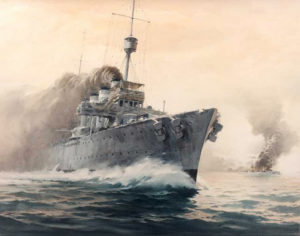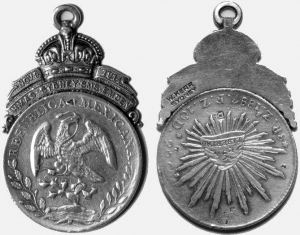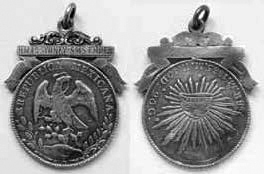| This paper, was first published by the Naval Historical Society of Australia in the March 2013 edition of the Naval Historical Review. |
On 9 November 1914 the RAN cruiser HMAS Sydney engaged and destroyed the German light cruiser and commerce raider SMS Emden. This one-and-a-half-hour gun battle off the Cocos – Keeling Islands in the Indian Ocean was the Royal Australian Navy’s first naval engagement.

The ‘Battle of Cocos’ resulted in Emden being run aground and battered by gunfire from Sydney to become a wrecked hulk. Sydney herself sustained some direct hits from Emden’s guns, but this did not affect her seaworthiness or her firepower. Sydney served with distinction throughout the subsequent four years of the war. Casualties were incurred by both vessels: Sydney suffered 4 ratings killed (one of whom died of his wounds) and 12 ratings wounded and Emden suffered 131 fatal casualties and 65 wounded of all ranks.
Following Emden’s stranding, salvage operations were commenced. Numerous items of her equipage and structure were salved and taken to Australia and Great Britain as War Trophies. During these salvage operations, 6,429 Mexican silver coins were recovered from two safes aboard Emden. There were, in addition, a number of US $20 gold coins recovered.
The vast majority of these silver coins was Mexican 8 Reale pieces (sometimes referred to as Dollars), but Mexican Peso pieces have also been noted. The obverse of the coin bore the Mexican National emblem of a spread-wing eagle with a snake in its beak surrounded by a wreath, with ‘REPUBLICA MEXICANA’ at top. The reverse of the coin featured the Cap of Liberty with a stylised star-burst behind with dates and lettering below. Simplistically, this lettering read as: denomination- -mintmark- -date- -assayer’s initial- -fineness. There were 12 different Mexican Mints represented and dates range from the latter 1880s to the 1890s. The Mexican Peso was only introduced in 1898, replacing the 8 Reale pieces and this no doubt accounts for the rarity of the Peso in the context of the ‘Emden Hoard’.
The Mexican 8 Reale and peso coins were the most popular international trade currency of the time throughout the East Indies and along the China Coast. Emden’s hoard was possibly taken as plunder and was probably also utilised to pay local levies and as wages for the ship’s company whilst in Asian waters. Surviving examples often bear Chinese ‘chop-mark’ counter stamps. It was common practice amongst the Chinese and Indian money changers (Shroffs) for them to assay and weigh coins of precious metal and then to stamp them with their own individual counter stamp or ‘chop’. Thus, if coins bearing these stamps were to be subsequently received back by the Shroff, he would be assured of their correct weight and fineness.
Of the 6,429 salvaged silver coins from the Emden hoard, 1,000 were mounted as commemorative medallions in 1918 by the Sydney jeweller and silversmith, W. Kerr. These mounted pieces were intended to be presented to all officers and ratings aboard Sydney at the time of the Cocos battle, or to the next of kin. Some were also presented to the staff on Cocos Island as well as to the Admiralty, Australian War Memorial and other ‘approved’ institutions. Some were also sold off to the public. Of the remaining unmounted coins, 653 were distributed by the Department of the Navy together with an authenticating letter bearing a facsimile signature of Captain John C.T. Glossop (Commanding Officer HMAS Sydney during the engagement), 343 were sold to the public and 4,433 were melted down at the Sydney Mint with all proceeds being donated to the RAN Relief Fund. At least one of the US $20 gold coins was presented to Captain Glossop (this example is today preserved in the Powerhouse Museum, Sydney).
 The Kerr mount was made in cast silver and featured a large ‘King’s’ (Tudor) crown which incorporated a loop on the orb to accommodate a fob chain or a ribbon. The crown was flanked by, and set upon, 3 scrolls reading ‘NOV 9’ / ‘1914’ and ‘HMAS SYDNEY: SMS EMDEN’. The reverse bore the stamped trade mark (not strictly a ‘hallmark’) ‘W. KERR’ and ‘SYDNEY’, but was otherwise plain. The whole mounting was sweated firmly to the host coin. Variations have been noted where the host coin has been mounted with the reverse to the fore, but generally the obverse is noted to the fore.
The Kerr mount was made in cast silver and featured a large ‘King’s’ (Tudor) crown which incorporated a loop on the orb to accommodate a fob chain or a ribbon. The crown was flanked by, and set upon, 3 scrolls reading ‘NOV 9’ / ‘1914’ and ‘HMAS SYDNEY: SMS EMDEN’. The reverse bore the stamped trade mark (not strictly a ‘hallmark’) ‘W. KERR’ and ‘SYDNEY’, but was otherwise plain. The whole mounting was sweated firmly to the host coin. Variations have been noted where the host coin has been mounted with the reverse to the fore, but generally the obverse is noted to the fore.
The Kerr mounted pieces were distributed unnamed, but many recipients had them privately engraved with their name and sometimes their service number and rating. Although originally issued without a ribbon, it has become accepted practice within the collecting fraternity to mount it upon a dark blue ribbon (similar to that of the 1882 Khedive Star ribbon). It is my belief that the original intention for this commemorative piece was for it to be worn in the manner of a gentleman’s watch-fob medal – albeit an overlarge one! Whatever the original intention, the Kerr Sydney-Emden medal is often found in collections mounted at the end of a recipient’s decoration and campaign medal group. There was no official medal for the Cocos battle. The usual combination of medals to those serving in Sydney who had participated in the action might arguably be the 1914-1915 Star, the British War Medal 1914-1918 and the Inter Allied Victory Medal 1914-1919. Of course, this combination could be enhanced by any Honours or Decorations gained by the recipient, any previous Campaign medals, Jubilee/Coronation medals or Long service and Good Conduct awards.
 In 2011 a possibly unique variant of the Kerr mounted coin appeared on the collecting market. In this case the top mount deviates dramatically from the usual Kerr design. It consists of a floreate scroll with suspension loop (probably intended for a neck chain) over a title scroll with chisel cut engraved lettering: ‘HMAS SYDNEY: SMS EMDEN’. The whole was in cast and hand chased silver. The plain reverse of the mount bore the stamp ‘W. KERR’ and ‘SILVER’.
In 2011 a possibly unique variant of the Kerr mounted coin appeared on the collecting market. In this case the top mount deviates dramatically from the usual Kerr design. It consists of a floreate scroll with suspension loop (probably intended for a neck chain) over a title scroll with chisel cut engraved lettering: ‘HMAS SYDNEY: SMS EMDEN’. The whole was in cast and hand chased silver. The plain reverse of the mount bore the stamp ‘W. KERR’ and ‘SILVER’.
As this piece turned up with its associated Glossop letter, it is reasonable to assume that it was a privately commissioned work added to one of the unmounted coins. Added to this is the fact that the scroll lettering has been hand engraved and that the general appearance is less well finished than the mass-produced Crown mount.
Although an unofficial medallion and not recognised under the official Honours and Awards system, the Kerr ‘Sydney-Emden’ medal is an historically important Australian Naval piece which has become accepted as a ‘Campaign Medal’ in its own right. As an actual relic of the RAN’s first Naval gun battle, the Kerr ‘Sydney-Emden’ medal holds a unique and privileged place in Australia’s Naval heritage.




